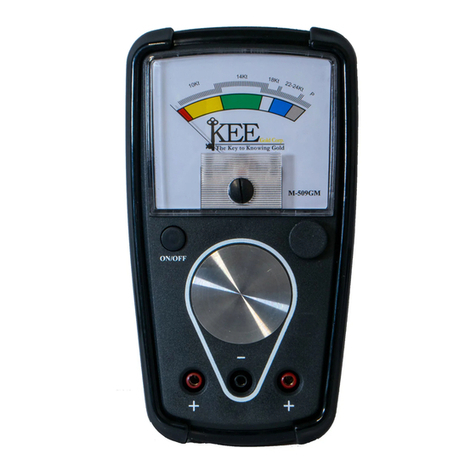HOW IT WORKS
Knowing the principle upon which a diamond tester works is like learning which gear
numbers to use depending on the steepness of the hill and the speed of the car, it may
be of interest to the beginner but for the experienced user it is totally irrelevant.
The tip of the tester warms up. Diamonds (and, to a lesser extent, rubies and sapphires
are 'cold'. A crude test is to touch the stone against your lip to feel the 'coldness'. The
diamond tester measures this relative 'coldness', i.e. how quickly the heat from the tip is
'drawn' into the stone. The faster the heat is drawn into the stone, the faster and further
the lights move up. Of course, if the stone really is cold (e.g. outside in the winter the
reaction will be quicker, or if the stone really is hot (e.g. from a hot shop window the
reaction will be slower
;so;
a small diamond won't have much 'coldness', it will 'draw' the heat slowly, the segments will light
up slowly, you have to turn the sensitivity up to get it to read DIAMOND. A small non-diamond
will be so 'warm' it won't draw the heat at all, the lights wont' move. A large diamond will 'draw'
the heat quickly, the lights will light up to DIAMOND in about one second. Some large non-
diamond will draw some heat (especially rubies and sapphires , they will make the lights move
up, but sluggishly, not at all like the reaction with a large diamond, but the chart will tell you to
turn the sensitivity down slightly, just in case.
MOISSANITE
Moissanite is a synthetic stone, it is the closest man has yet come to imitating diamond, it is
nearly as hard as diamond, and it does appear, at first glance, just like diamond an it registers
DIAMOND on all iamon testers.
Some questions and answers:
Q. Will a DIAMOND TESTER distinguish diamond from Moissanite?
A. No. Diamond testers work on Thermal Conductivity and the thermal conductivity of the
stones is too similar to make this a reliable test
Q. Is there a tester that will distinguish Moissanite from diamond?
A. Yes, we sell electronic 'Moissanite testers' but these will on y distinguish Moissanite from
diamond, you will still need the DIAMOND TESTER to distinguish diamond from dozens
of other similar-looking stones.
Q, Is there one tester that will test for both diamonds and Moissanite?
A. Yes, and the very latest model is quite reliable provi ing you follow the instructions
precisely. The beauty of the DT-5 Diamond Tester is that even if you set the sensitivity
wrongly, it is still obvious as to whether you have a diamond or not. The combined tester
requires you to follow the instructions very precisely, including cleaning the stone
thoroughly with alcohol, and also requires an extra-steady hand and perfect eyesight.
DISCLAIMER: All equipment must be used in conjunction with the user’s skill,
knowledge and experience. Under no circumstances shall QUICKTEST be liable for
direct or indirect loss sustained in connection with any item. It is your responsibility to
regularly check equipment against known samples, to ensure that it is working correctly.
FURTHER INFORMATION: www.quicktest.co.uk





















